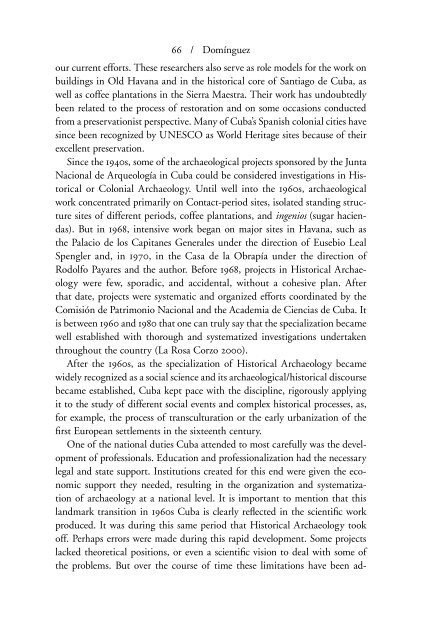Dialogues in Cuban Archaeology
by L. Antonio Curet, Shannon Lee Dawdy, and Gabino La Rosa Corzo
by L. Antonio Curet, Shannon Lee Dawdy, and Gabino La Rosa Corzo
Create successful ePaper yourself
Turn your PDF publications into a flip-book with our unique Google optimized e-Paper software.
66 / Domínguez<br />
our current efforts. These researchers also serve as role models for the work on<br />
build<strong>in</strong>gs <strong>in</strong> Old Havana and <strong>in</strong> the historical core of Santiago de Cuba, as<br />
well as coffee plantations <strong>in</strong> the Sierra Maestra. Their work has undoubtedly<br />
been related to the process of restoration and on some occasions conducted<br />
from a preservationist perspective. Many of Cuba’s Spanish colonial cities have<br />
s<strong>in</strong>ce been recognized by UNESCO as World Heritage sites because of their<br />
excellent preservation.<br />
S<strong>in</strong>ce the 1940s, some of the archaeological projects sponsored by the Junta<br />
Nacional de Arqueología <strong>in</strong> Cuba could be considered <strong>in</strong>vestigations <strong>in</strong> Historical<br />
or Colonial <strong>Archaeology</strong>. Until well <strong>in</strong>to the 1960s, archaeological<br />
work concentrated primarily on Contact-period sites, isolated stand<strong>in</strong>g structure<br />
sites of different periods, coffee plantations, and <strong>in</strong>genios (sugar haciendas).<br />
But <strong>in</strong> 1968, <strong>in</strong>tensive work began on major sites <strong>in</strong> Havana, such as<br />
the Palacio de los Capitanes Generales under the direction of Eusebio Leal<br />
Spengler and, <strong>in</strong> 1970, <strong>in</strong> the Casa de la Obrapía under the direction of<br />
Rodolfo Payares and the author. Before 1968, projects <strong>in</strong> Historical <strong>Archaeology</strong><br />
were few, sporadic, and accidental, without a cohesive plan. After<br />
that date, projects were systematic and organized efforts coord<strong>in</strong>ated by the<br />
Comisión de Patrimonio Nacional and the Academia de Ciencias de Cuba. It<br />
is between 1960 and 1980 that one can truly say that the specialization became<br />
well established with thorough and systematized <strong>in</strong>vestigations undertaken<br />
throughout the country (La Rosa Corzo 2000).<br />
After the 1960s, as the specialization of Historical <strong>Archaeology</strong> became<br />
widely recognized as a social science and its archaeological/historical discourse<br />
became established, Cuba kept pace with the discipl<strong>in</strong>e, rigorously apply<strong>in</strong>g<br />
it to the study of different social events and complex historical processes, as,<br />
for example, the process of transculturation or the early urbanization of the<br />
¤rst European settlements <strong>in</strong> the sixteenth century.<br />
One of the national duties Cuba attended to most carefully was the development<br />
of professionals. Education and professionalization had the necessary<br />
legal and state support. Institutions created for this end were given the economic<br />
support they needed, result<strong>in</strong>g <strong>in</strong> the organization and systematization<br />
of archaeology at a national level. It is important to mention that this<br />
landmark transition <strong>in</strong> 1960s Cuba is clearly re®ected <strong>in</strong> the scienti¤c work<br />
produced. It was dur<strong>in</strong>g this same period that Historical <strong>Archaeology</strong> took<br />
off. Perhaps errors were made dur<strong>in</strong>g this rapid development. Some projects<br />
lacked theoretical positions, or even a scienti¤c vision to deal with some of<br />
the problems. But over the course of time these limitations have been ad-


















